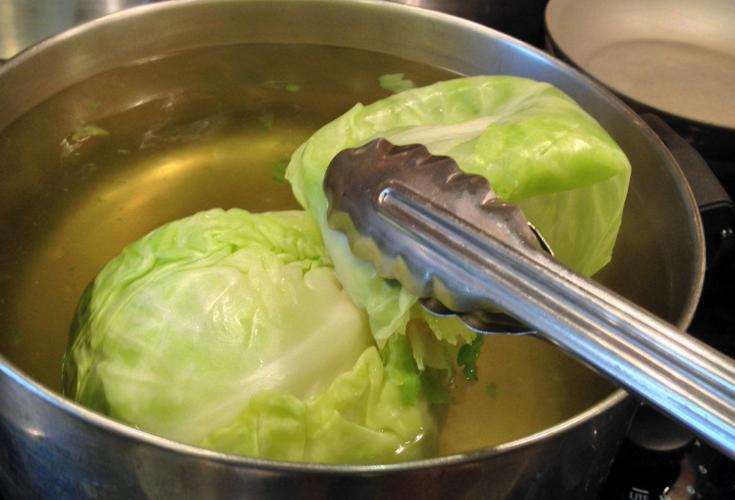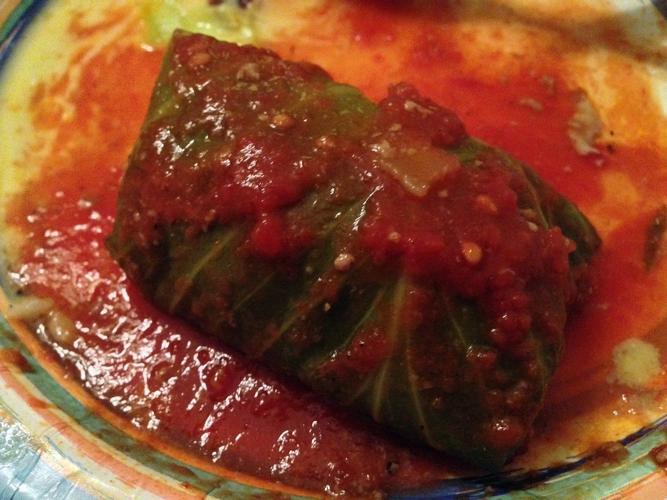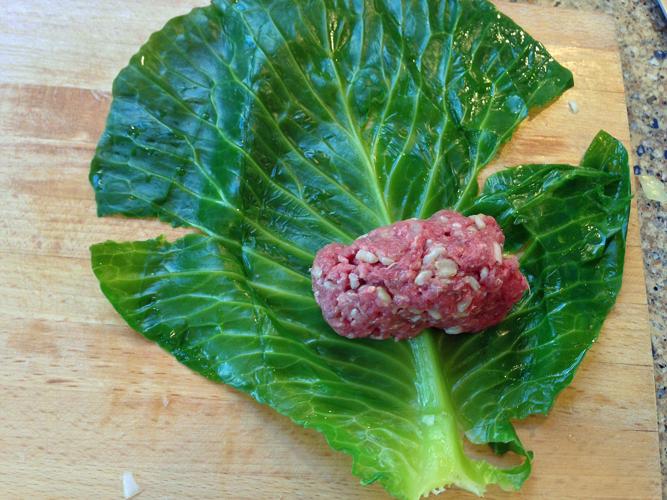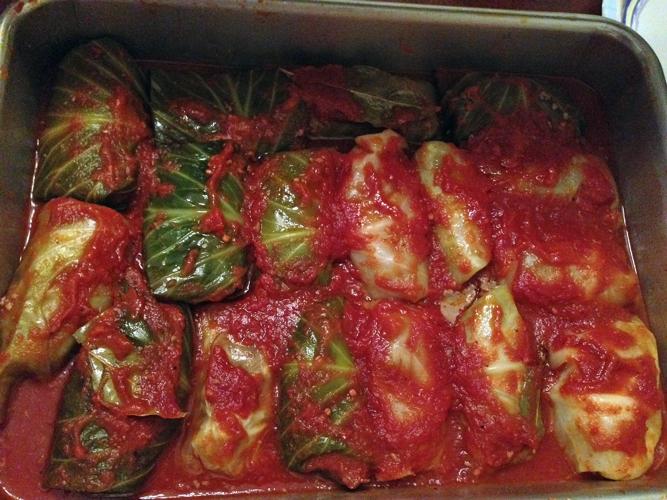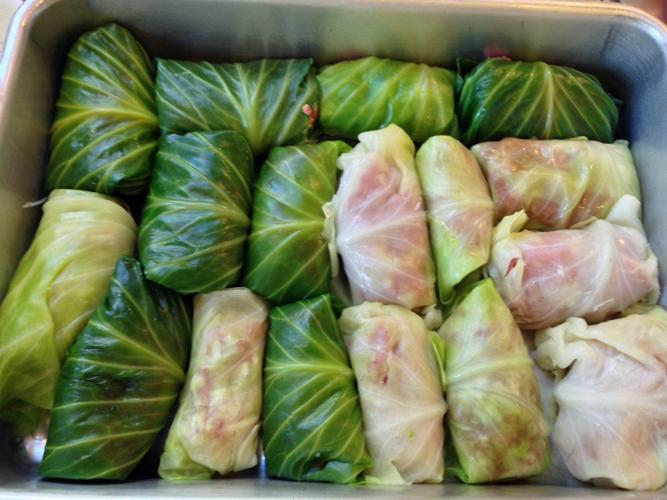Cabbage is humble, but worthy of the greatest respect, the great Alice Waters has written. In honor of St. Patrick's Day 2015, we honor the green (or purple) globe.
Did you know ...?
1. Cabbage is one of the world's oldest vegetables; it probably was domesticated by Celts in Europe from a wild field cabbage by 1,000 B.C.
2.For those on paleo or low-carb diets, cabbage can substitute for rice or noodles. Shred or chop it in the food processor and saute or braise briefly in broth or another flavorful liquid of your choice, then use it as a base for your sauce, proteins or whatever.
3. Imagine Korea without kimchi, or Germany without sauerkraut. Cabbage grows all over the world. That's why there are so many wonderful ethnic favorite dishes made with it. Check out our recipes for Italian-Style Cabbage, Sweet Cabbage Pierogi and Thai Cabbage Salad, to name just a few.
4. It's good to have cabbage in your kitchen during hurricane season, because it keeps well at room temperature for a long time. If you are without power, have eaten the other fresh vegetables and fruit and are down to canned vegetables, the crisp raw texture of cabbage is a welcome variation.
5. If you know halushki, you're probably from Pittsburgh. It's a cabbage-based Eastern-European peasant dish with noodles, which has hung on in the region. The Post-Gazette has the story and a recipe.
6. Cabbage is one of the best cancer-fighters. Cabbage is loaded with compounds "strongly linked" to cancer prevention.
7. There are tons more nutritional reasons to eat cabbage, which always makes the lists of the world's healthiest foods. It's loaded with fiber and vitamins C and K, among other things. Raw and lightly cooked cabbage is the most nutritious. All types of cabbage - savoy, purple, etc. - have benefits and should be included in the diet.
8. Cabbage is well known as an aid to weight loss, (although we are not going to talk about the cabbage diet). One cup of raw cabbage is only 22 calories, and can make you feel full.
9. Cabbage can star in gumbo. Gombo Choux is cabbage gumbo. It's an old, weird New Orleans recipe but one I really liked.
10. You know that cabbage is stinky when cooked for long periods of time. Why? It's loaded with sulfur compounds (and Brussels sprouts have even more). To avoid, cut it into thin (1/4-inch) shreds or slices or wedges so it will cook quicker, then gently steam or simmer just until tender. Or, counteract the sulfur with an acid. Simmer gently in apple juice, cider, white wine, or water and white vinegar.
To cook cabbage with corned beef, remove some of the liquid from the beef near the end of cooking, and use it to briefly simmer the cabbage.
11. Cabbage is great for your stomach. An old European recipe to heal stomach ulcers, drinking one cup of cabbage juice a day, was studied and shown to heal ulcers in 10 days.
12. Stir-fries benefit greatly from cabbage, and you can add it to the filling for savory pastries. To make an easy side dish, stir-fry it with ginger and apples, or pair it with dried fruits and spices such as allspice and sesame.
LAGNIAPPE: Everybody in New Orleans knows this, so our final what-to-know fact is for people who are "not from here." At St. Patrick's Day parades, riders on floats hand out fresh cabbages as well as beads.
Really.
Lucky us: Free cabbage in the streets of New Orleans and Metairie!
You know how you remember a dish years after eating it? For ages I had a longing for my friend Stefanie's cabbage rolls, the best I ever ate. She dug up the old recipe for me, for which I'm immensely grateful.
Stefanie now has four kids, and she said she doesn't make this as cabbage rolls anymore, since she is the only one her family who eats them.
They are, she says, "seriously potchke" - fussy, time-consuming to make. Instead, she makes a ton of the sauce, rolls the meat into balls and cooks them in the sauce. And now she adds sriracha or other hot sauce, and "tons of bay leaves" to the sauce.
In my opinion, you should at least double the sauce amounts. I doubled the meat, too, using lean beef. I added rice (brown rice from takeout Chinese) for one batch, and made the second batch carb-free. I made the rice-filled half into cabbage rolls, along with about a quarter of the second batch, so I had several rolls with no rice.
The potchke part is wrestling with the cabbage leaves. Stefanie advised me to freeze the cabbage to soften the leaves for rolling, but I didn't start in time. Instead, with tongs and a spoon, I was able to bend and snap or cut off individual leaves as they softened in a pot of boiling water.
I lined a deep-dish pie pan with the remaining interior cabbage leaves, filling it with the remaining sauce and meatballs. I folded the leaves over the top and froze it, to bake later.
The cabbage rolls are potchke, yes, but seriously, wonderfully as delicious as I remembered. A big panful was quickly inhaled by family and friends.
Cabbage rolls freeze well.
Makes about 20
1 large head cabbage
MEAT MIXTURE:
1 pound chopped meat
3/4 cup cooked rice
1/4 cup minced onion
1 egg
1 teaspoon salt
Pepper
SAUCE:
1 cup tomato sauce
3 tablespoons lemon juice
1/4 cup sweet wine* (think Manischevitz)
3 tablespoons brown sugar
2 tablespoons oil
1 or 2 bay leaves (or more)
Salt and pepper
Optional: Sriracha or other hot sauce
Freeze the cabbage, or parboil it in a large pot of boiling well-salted water. Pull leaves off individually and let drain on a sheet pan covered with paper towels, until you have about 20 leaves.
In a large bowl, mix all meat ingredients. Form into rolls about 2 inches long by 1 inch in diameter. Lay roll onto bottom third of one cabbage leaf. Fold in sides and roll up like a burrito.
Lay finished rolls, seam-side-down, into a 13-by-9-inch baking pan.
Preheat oven to 375 degrees.
Mix all the sauce ingredients. Pour evenly over the cabbage rolls.
Cover with foil and bake for one hour.
*I used moscato. A sweeter reisling, or sweet sherry, could also work. Or use regular wine and another tablespoon brown sugar, or honey.
Cabbage Meatball Pie: Double the above recipe. Make half as cabbage rolls, or make two pies. Line a deep-dish pie plate with inner leaves of cabbage, letting the leaves naturally fold over the edges. Roll half the meat into balls, and put them in the center of the pie. Cover with remaining tomato sauce. Fold edges of the cabbage over the filling, then put another couple leaves on top to cover all the filling. Cover with foil. Freeze if desired.
Bake at 350 degrees for one hour, covered, until bubbly and browned around the edges. To test for doneness, insert the tip of a knife into one of the meatballs. When removed, the tip should be hot.
To cook from frozen, put the pan in a cold oven and turn to 350 degrees. Cook two hours, until hot and bubbly and browned around the edges.
Serve in bowls with Parmesan, if desired.
If you like roasted brussels sprouts, you will love this super-simple recipe for green or purple cabbage. Use a heavy or cast-iron pan. Some recipes use half a head of purple cabbage and half a head of green, so the wedges contrast. The trick is: Don't be afraid of using high heat.
Makes 4 to 8 servings
1 small head cabbage
Olive oil
Salt and pepper
Remove any loose outer leaves. Cut cabbage through the core into quarters, then into eights, leaving enough of the core so wedges stay intact.
Heat about 3 tablespoons oil in a heavy skillet until very hot. Add the wedges and cook 3 to 5 minutes on one side, until well-browned. Use tongs to flip onto the other side and cook another 5 minutes or so, until browned and crispy, and tender inside.
Alternately, brush the cabbage with the oil and heat a heavy sheet pan or large cast-iron skillet in the oven at 400 degrees for 15 minutes. Put the cabbage onto the pan, which should sizzle. Cook until browned on one side, then flip and brown again.
When cabbage is done by either method, add salt and pepper to taste, and serve at once.
This slow-cooker, vegetarian take on cabbage rolls is from "The Big Book of One-Pot Dinners" by Betty Crocker and copyright 2015 by General Mills. It's brand new from, and used by permission of, Houghton Mifflin Harcourt Publishing Company. All rights reserved.
Makes 4 servings (2 rolls each)
8 large cabbage leaves
1 can (14 ounces) reduced fat (lite) unsweetened coconut milk
1/2 cup pineapple preserves
1 cup cooked orzo or rosamarina pasta
1 can (15 ounces) black beans, drained, rinsed
1 medium onion, chopped (1/2 cup)
1/3 cup raisins
1/3 cup cashew pieces
2 teaspoons curry powder
1/2 teaspoon garlic salt
Flaked coconut, if desired
Additional cashew pieces, if desired
In large bowl, cover cabbage leaves with boiling water. Cover; let stand about 10 minutes or until leaves are limp. Meanwhile, spray 3- to 4-quart slow cooker with cooking spray. In small bowl, mix coconut milk and preserves. Spread 1/2 cup mixture in bottom of slow cooker; set remaining mixture aside. In medium bowl, mix pasta, beans, onion, raisins, 1/3 cup cashews, curry powder and garlic salt.
Remove cabbage leaves from water; drain. Place about 1/3 cup pasta mixture at stem end of each leaf. Roll leaf around pasta mixture, tucking in sides. Place as many cabbage rolls, seam side down, as will comfortably fit in slow cooker. Cover with 1/2 cup of the remaining coconut milk mixture. Repeat with remaining cabbage rolls. Pour remaining coconut milk mixture over rolls.
Cover; cook on Low heat setting 7 to 9 hours (or on High heat setting 3 hours 30 minutes to 4 hours 30 minutes).
With spatula, carefully remove cabbage rolls, one at a time, from slow cooker; place on serving platter. Sprinkle rolls with coconut and additional cashews.
Per serving: 670 calories; 27 g total fat (saturated fat 19 g, trans fat 0g); no cholesterol; 620 mg sodium; 91 g carbohydrate; 16 g dietary fiber; 16 g protein.
*
Want to browse through more cabbage recipes? Type the word "cabbage" into the title search box of our Recipe Database.
by Caspio
to load this Caspio
Food editor Judy Walker can be reached at jwalker@nola.com. Follow her on Twitter (@JudyWalkerCooks) and Facebook (JudyWalkerCooks).

